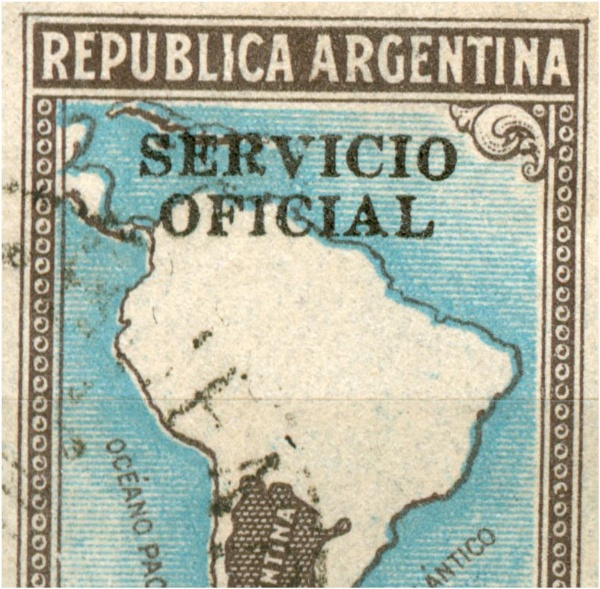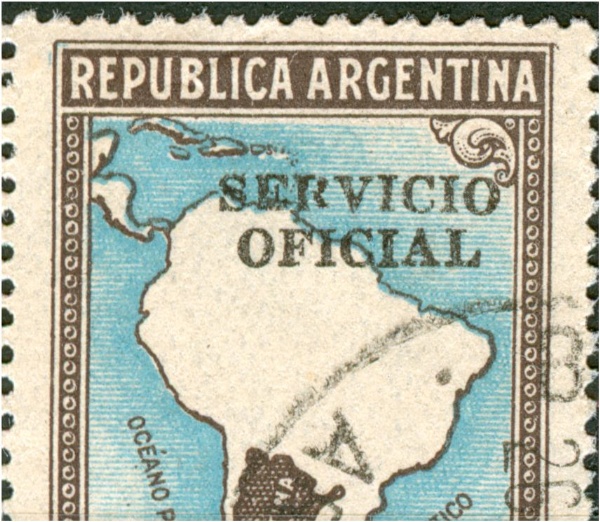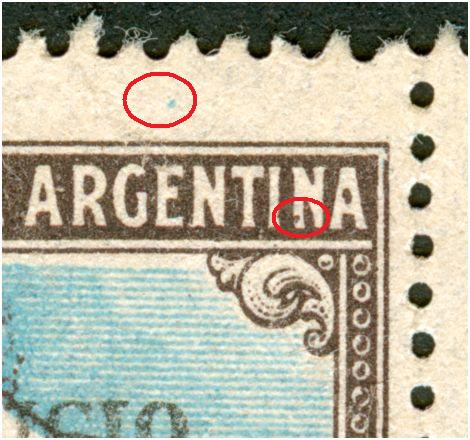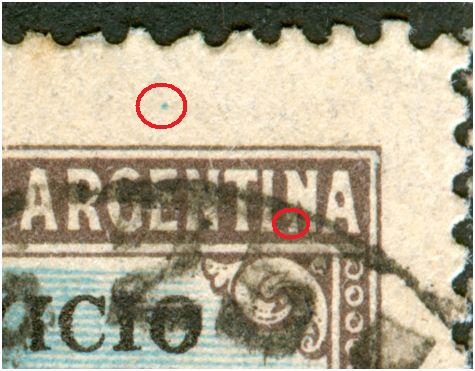Retoques, errores y variedades de Proceres y Riquezas
Moderador: rubiera
Re: Retoques, errores y variedades de Proceres y Riquezas
Rein
I don't know because all I have are singles....that is why your Departmental blocks are so useful. I wouldn't mind if you sent me scans of these.
----------------------------------
No se donde pertencen estas variedades....y esta es la razon por la cual sus bloques de Departamentos son tan valiosos. Me gustaria recibir escans de estos.
saludos
tony
I don't know because all I have are singles....that is why your Departmental blocks are so useful. I wouldn't mind if you sent me scans of these.
----------------------------------
No se donde pertencen estas variedades....y esta es la razon por la cual sus bloques de Departamentos son tan valiosos. Me gustaria recibir escans de estos.
saludos
tony
sitio Ingles/Español de P y R I
http://www.somestamps.com/arg3551/index.htm
sitio general:
http://www.somestamps.com/
blog de P y R I en Ingles
http://arg3551.blogspot.com/
http://www.somestamps.com/arg3551/index.htm
sitio general:
http://www.somestamps.com/
blog de P y R I en Ingles
http://arg3551.blogspot.com/
- Rein
- Usuario Colaborador

- Mensajes: 6258
- Registrado: 13 Mar 2009 15:59
- Ubicación: Leiden, Netherlands
- Contactar:
Re: Retoques, errores y variedades de Proceres y Riquezas
Tony,
I hope the scans did arrive!?
I found a tiny, little dot - underneath the "I" of Argentina in all 1peso no-borders stamps.
as to the 30c it looks like we need to establish the basic characteristics of 10 [=2x5] stamps that get repeated. When you have an isolated stamp and discover a characteristic that you have seen on another solitary stamp, you do not know on beforehand whether it is a characteristic that only occurs once (1x) in a sheet or 10 times [or more!]
I hope the scans did arrive!?
I found a tiny, little dot - underneath the "I" of Argentina in all 1peso no-borders stamps.
as to the 30c it looks like we need to establish the basic characteristics of 10 [=2x5] stamps that get repeated. When you have an isolated stamp and discover a characteristic that you have seen on another solitary stamp, you do not know on beforehand whether it is a characteristic that only occurs once (1x) in a sheet or 10 times [or more!]
- Rein
- Usuario Colaborador

- Mensajes: 6258
- Registrado: 13 Mar 2009 15:59
- Ubicación: Leiden, Netherlands
- Contactar:
Re: Retoques, errores y variedades de Proceres y Riquezas
The 1peso without borders has a few characteristics that I have seen more than once, but I do not know whether this occurs only once or more often 
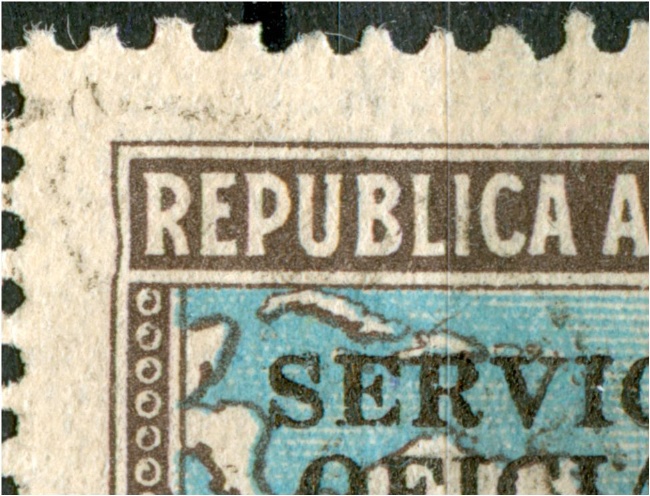
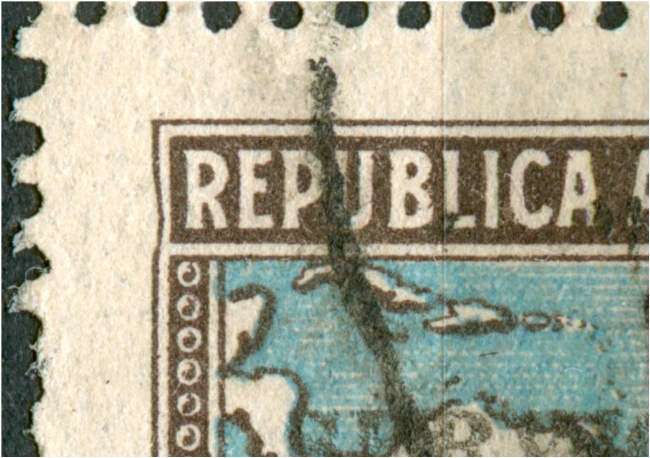
Both options are open as a second brown dot is in the margins above 'A A"!
The tiny dot underneath the "I ":
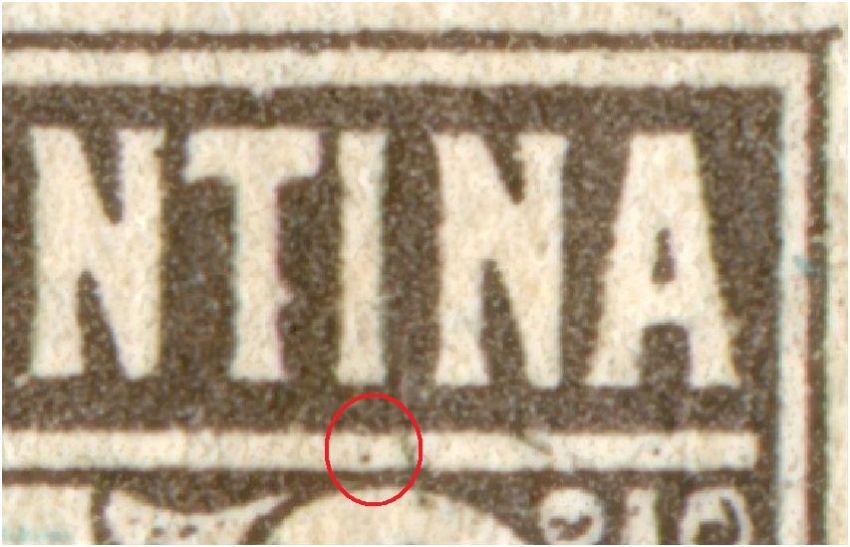


Both options are open as a second brown dot is in the margins above 'A A"!
The tiny dot underneath the "I ":

- Rein
- Usuario Colaborador

- Mensajes: 6258
- Registrado: 13 Mar 2009 15:59
- Ubicación: Leiden, Netherlands
- Contactar:
Re: Retoques, errores y variedades de Proceres y Riquezas
The 5pesos also has a characteristic that at first sight seen to occur more often! 
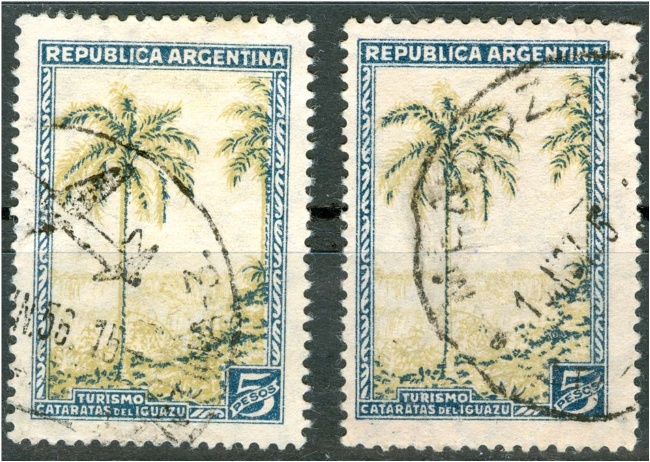
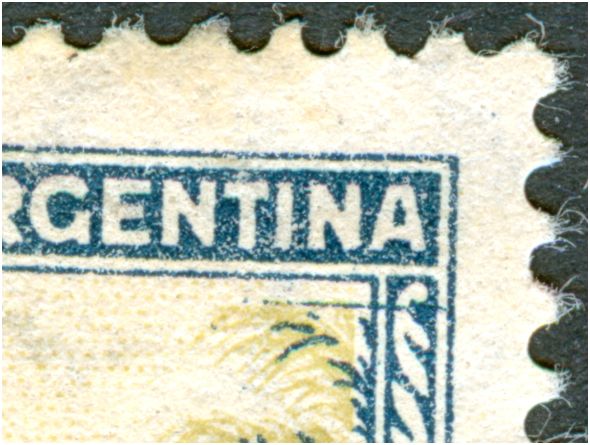
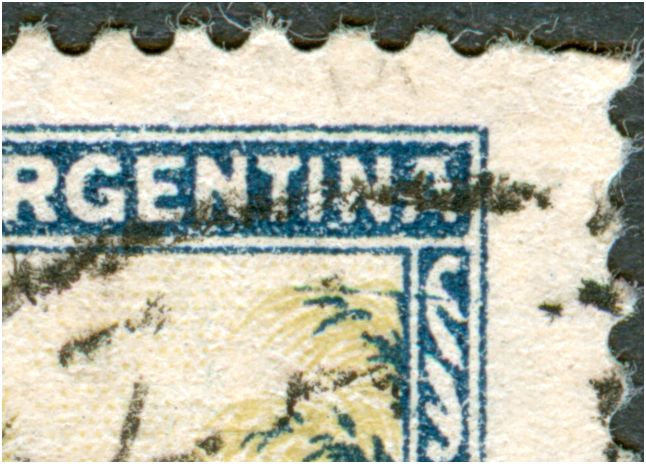
They are similar but not the same!



They are similar but not the same!
Re: Retoques, errores y variedades de Proceres y Riquezas
Rein,
Nice find for the 1 peso no boundaries, I will have to check my selection. The 5 pesos plate varieties you mention and others I discuss here:
{link below}
My all time favorite is the long line in background variety, which is almost impossible to find
{picture below}
-------------------------------------
Que bueno que tengo otra variedad de plancha a buscar en mi seleccion del 1 peso sin limites. Las variedades de plancha del 5 peso las mantengo aqui:
http://www.somestamps.com/domain-argent ... rs-5P.html
Mi favorita es la que tiene una linea en el centro, imposible de encontrar a simple vista

Nice find for the 1 peso no boundaries, I will have to check my selection. The 5 pesos plate varieties you mention and others I discuss here:
{link below}
My all time favorite is the long line in background variety, which is almost impossible to find
{picture below}
-------------------------------------
Que bueno que tengo otra variedad de plancha a buscar en mi seleccion del 1 peso sin limites. Las variedades de plancha del 5 peso las mantengo aqui:
http://www.somestamps.com/domain-argent ... rs-5P.html
Mi favorita es la que tiene una linea en el centro, imposible de encontrar a simple vista

sitio Ingles/Español de P y R I
http://www.somestamps.com/arg3551/index.htm
sitio general:
http://www.somestamps.com/
blog de P y R I en Ingles
http://arg3551.blogspot.com/
http://www.somestamps.com/arg3551/index.htm
sitio general:
http://www.somestamps.com/
blog de P y R I en Ingles
http://arg3551.blogspot.com/
- Rein
- Usuario Colaborador

- Mensajes: 6258
- Registrado: 13 Mar 2009 15:59
- Ubicación: Leiden, Netherlands
- Contactar:
Re: Retoques, errores y variedades de Proceres y Riquezas
Tony,
we do have a terminology problem now as the traditonal "plate flaw" [variedad de plancha] is not always the adequate term for it.
It should be OK to use that for a characteristic that only occurs once on the printing plate [cylinder] but when it occurs repetitively within a printing sheet?
The term type will come close but is also not adequate as it refers to differences in design that occur in different printing forms used at the same time or subsequently. That is within the printing form there is only 1 version of that type.
It looks now that we have 10 subtypes for each of our beloved PyR I 's!!
A nice job to describe them all 10 for each value.
I can try to do that for the 30c Lanas and you may do the same having the scans. In one block the dot in the right top corner is in a row on top and in the other block it is at the bottom - so both blocks cover 9 horizontal rows of the counter sheet.....
we do have a terminology problem now as the traditonal "plate flaw" [variedad de plancha] is not always the adequate term for it.
It should be OK to use that for a characteristic that only occurs once on the printing plate [cylinder] but when it occurs repetitively within a printing sheet?
The term type will come close but is also not adequate as it refers to differences in design that occur in different printing forms used at the same time or subsequently. That is within the printing form there is only 1 version of that type.
It looks now that we have 10 subtypes for each of our beloved PyR I 's!!
A nice job to describe them all 10 for each value.
I can try to do that for the 30c Lanas and you may do the same having the scans. In one block the dot in the right top corner is in a row on top and in the other block it is at the bottom - so both blocks cover 9 horizontal rows of the counter sheet.....
-
patagonian
Re: Retoques, errores y variedades de Proceres y Riquezas
Si fuera litografía, creo que en español lo llamaríamos "variedad de reporte", que se repite tantas veces en la plancha como veces se copie el block reporte, para crear la piedra-máquina.
Desconozco la terminología propia del procedimiento offset, pero entiendo que la idea es similar.
Por ejemplo, en otra emisión que conozco mejor: el 50c Mitre de la Kidd, el "5" con el trazo vertical roto corresponde al tipo (o posición de reporte) Nro. 2, que se repite 10 veces en la plancha.
Y en esa emisión, también hay variedades repetitivas que sólo existen en una determinada posición de la plancha pero en toda la emisión, como el manchón entre las cifras de la pos. 85; otras variedades esporádicas pero registradas (mancha en la barba) y algunas quizás únicas ("toscano").
Espero se pueda unificar la terminología porque es fuente de muchos malentendidos, máxime cuando hay más de un idioma en uso.
Desconozco la terminología propia del procedimiento offset, pero entiendo que la idea es similar.
Por ejemplo, en otra emisión que conozco mejor: el 50c Mitre de la Kidd, el "5" con el trazo vertical roto corresponde al tipo (o posición de reporte) Nro. 2, que se repite 10 veces en la plancha.
Y en esa emisión, también hay variedades repetitivas que sólo existen en una determinada posición de la plancha pero en toda la emisión, como el manchón entre las cifras de la pos. 85; otras variedades esporádicas pero registradas (mancha en la barba) y algunas quizás únicas ("toscano").
Espero se pueda unificar la terminología porque es fuente de muchos malentendidos, máxime cuando hay más de un idioma en uso.
- Rein
- Usuario Colaborador

- Mensajes: 6258
- Registrado: 13 Mar 2009 15:59
- Ubicación: Leiden, Netherlands
- Contactar:
Re: Retoques, errores y variedades de Proceres y Riquezas
Nestor,
the terminology is dependent on the method of printing. We should know the method of printing first.
Lithography is different from offset-litho, and within for instance photogravure there are several developments since 1914 that hardly any philatelist knows about.
So we can NOT have a unified terminology for all printing methods. Philatelist got accustomed to the terms that were OK in the 1920-ies when we still had lithography and typography of separate types "tied together" on a flat plate, recess from copper engraved plates, etc...
Using the old terms for later developments may lead to great misunderstandings. The term plate flaw is one of them.....
Philatelists should get used to the idea that most important is to get the quintessence of a certain method and then try to describe and give names to all the phenomena that go with it. Some may turn out to be a bit universal like the direction of printing thanks to the fact that printing ink tends to flow in a particular direction when coming from a cylindrical printing form. It was discovered in photogravure printed stamps but I found it in recess-printng as well and even [or quite rightly so] in offset-litho. This phenomenon of the ink flowing in a particular direction is quite often mistaken for double impression or re-entries.....
the terminology is dependent on the method of printing. We should know the method of printing first.
Lithography is different from offset-litho, and within for instance photogravure there are several developments since 1914 that hardly any philatelist knows about.
So we can NOT have a unified terminology for all printing methods. Philatelist got accustomed to the terms that were OK in the 1920-ies when we still had lithography and typography of separate types "tied together" on a flat plate, recess from copper engraved plates, etc...
Using the old terms for later developments may lead to great misunderstandings. The term plate flaw is one of them.....
Philatelists should get used to the idea that most important is to get the quintessence of a certain method and then try to describe and give names to all the phenomena that go with it. Some may turn out to be a bit universal like the direction of printing thanks to the fact that printing ink tends to flow in a particular direction when coming from a cylindrical printing form. It was discovered in photogravure printed stamps but I found it in recess-printng as well and even [or quite rightly so] in offset-litho. This phenomenon of the ink flowing in a particular direction is quite often mistaken for double impression or re-entries.....
Re: Retoques, errores y variedades de Proceres y Riquezas
Nestor, Rein
It is true that I always refer to plate varieties, but it is true that we have two types of plate varieties:
1. Master die varieties that are a special, repetitive type of plate variety.
2. plate varieties that are not repetitive in the sheet, and occur in the plate after it has been made.
-----------------------
Es verdad que siempre me refiero a variedades de plancha, pero es verdad que tenemos dos tipos:
1. Variedades de plancha proveniented del cliche patron, o maestro, las cuales son variedades de plancha especiales, y se encuentran repetidas en la plancha.
2. variedades de plancha (no repetitivas, que ocurren en la plancha despues de que ha sido confeccionada.
saludos
tony
It is true that I always refer to plate varieties, but it is true that we have two types of plate varieties:
1. Master die varieties that are a special, repetitive type of plate variety.
2. plate varieties that are not repetitive in the sheet, and occur in the plate after it has been made.
-----------------------
Es verdad que siempre me refiero a variedades de plancha, pero es verdad que tenemos dos tipos:
1. Variedades de plancha proveniented del cliche patron, o maestro, las cuales son variedades de plancha especiales, y se encuentran repetidas en la plancha.
2. variedades de plancha (no repetitivas, que ocurren en la plancha despues de que ha sido confeccionada.
saludos
tony
sitio Ingles/Español de P y R I
http://www.somestamps.com/arg3551/index.htm
sitio general:
http://www.somestamps.com/
blog de P y R I en Ingles
http://arg3551.blogspot.com/
http://www.somestamps.com/arg3551/index.htm
sitio general:
http://www.somestamps.com/
blog de P y R I en Ingles
http://arg3551.blogspot.com/
- Rein
- Usuario Colaborador

- Mensajes: 6258
- Registrado: 13 Mar 2009 15:59
- Ubicación: Leiden, Netherlands
- Contactar:
Re: Retoques, errores y variedades de Proceres y Riquezas
The 25c also has a few characteristics that may be occuring only once per sheet I assume:
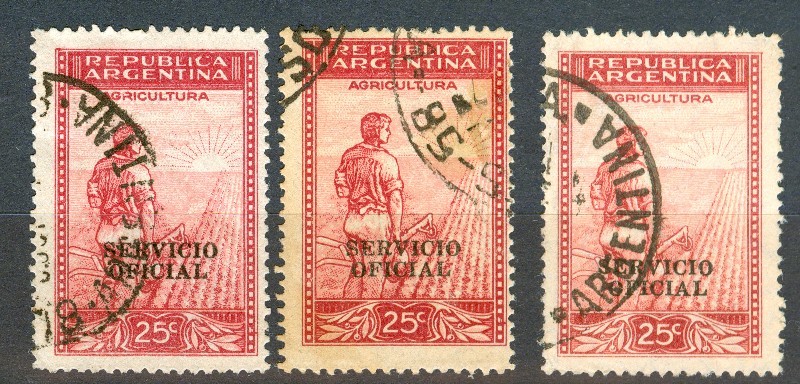
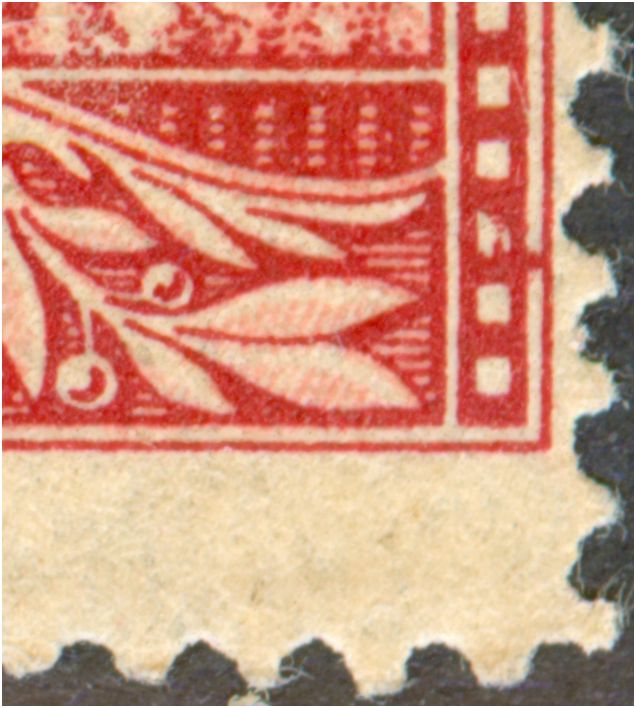
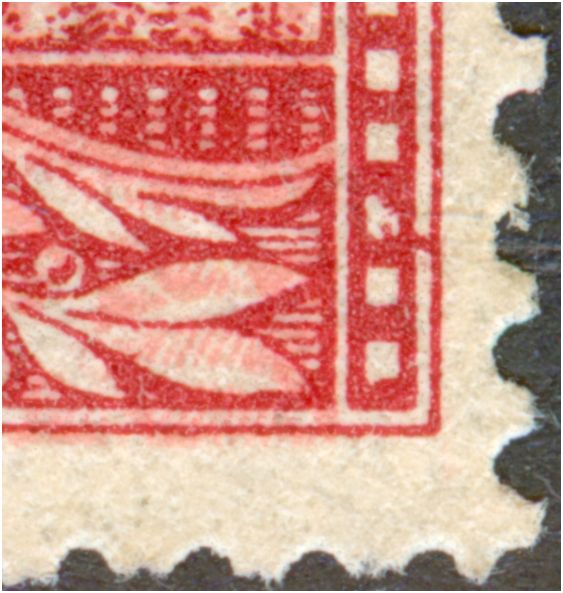
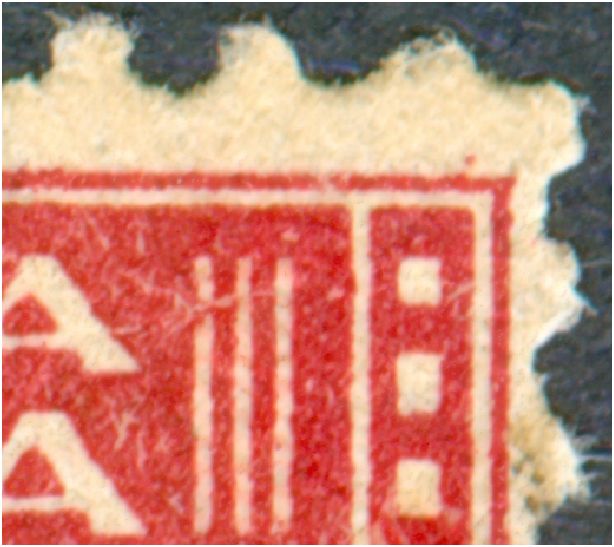
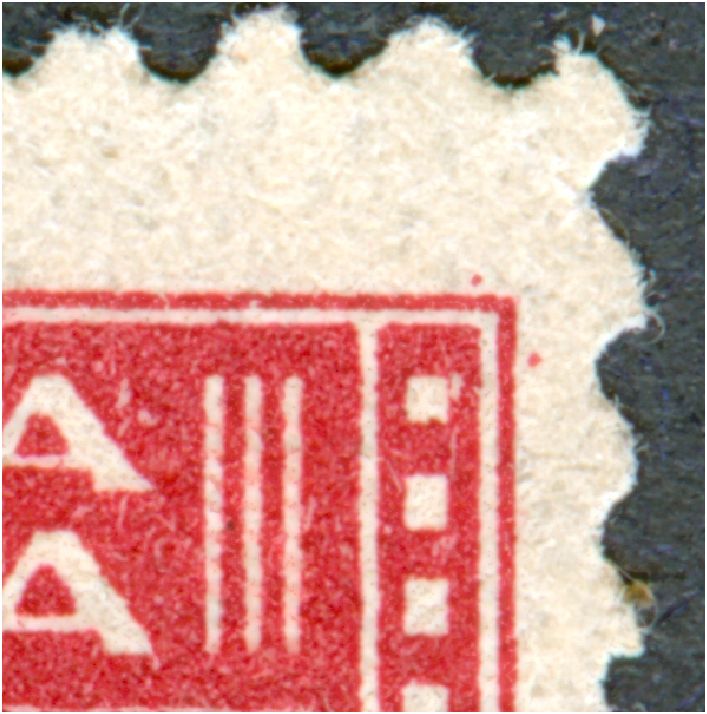





- Rein
- Usuario Colaborador

- Mensajes: 6258
- Registrado: 13 Mar 2009 15:59
- Ubicación: Leiden, Netherlands
- Contactar:
Re: Retoques, errores y variedades de Proceres y Riquezas
The 25c also has a few characteristics that may be occuring only once per sheet I assume:
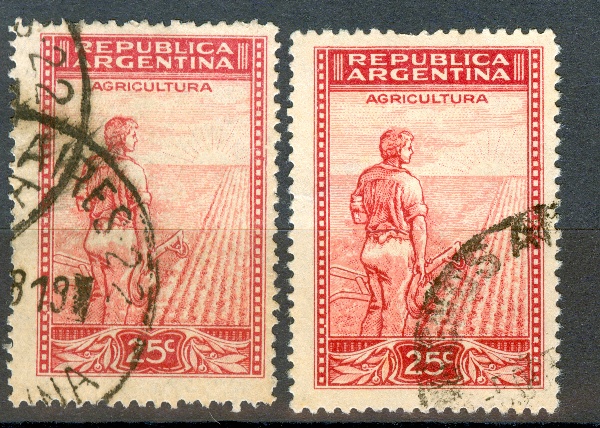
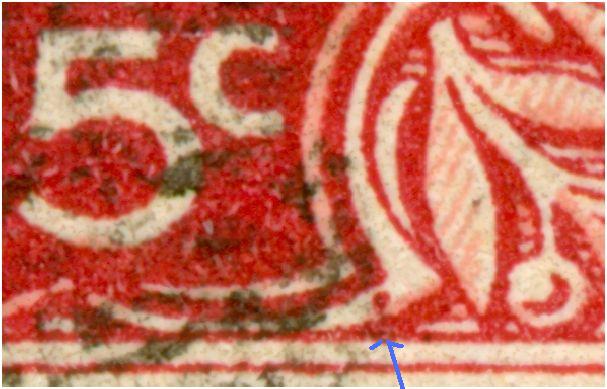
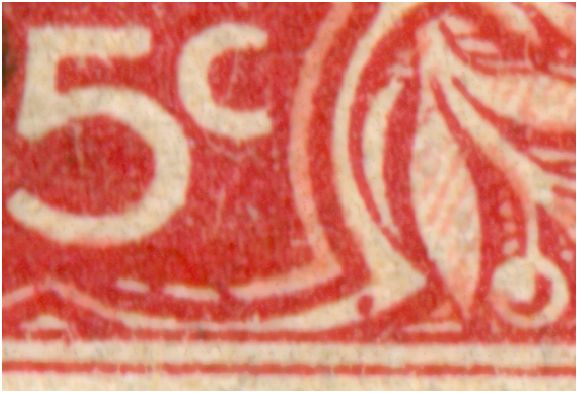



- Rein
- Usuario Colaborador

- Mensajes: 6258
- Registrado: 13 Mar 2009 15:59
- Ubicación: Leiden, Netherlands
- Contactar:
Re: Retoques, errores y variedades de Proceres y Riquezas
Tony,rubiera escribió:Nestor, Rein
It is true that I always refer to plate varieties, but it is true that we have two types of plate varieties:
1. Master die varieties that are a special, repetitive type of plate variety.
2. plate varieties that are not repetitive in the sheet, and occur in the plate after it has been made.
-----------------------
Es verdad que siempre me refiero a variedades de plancha, pero es verdad que tenemos dos tipos:
1. Variedades de plancha proveniented del cliche patron, o maestro, las cuales son variedades de plancha especiales, y se encuentran repetidas en la plancha.
2. variedades de plancha (no repetitivas, que ocurren en la plancha despues de que ha sido confeccionada.
saludos
tony
when discussing the (photographically reproduced) offset-litho stamps of the PyR I issue I suggest we have 3 types of "plate characteristics":
- 1st occuring in every single stamp of the (printers) sheet i.e. it was present in the original photograph or got there when reducing the size to that of a stamp;
- 2nd occuring in a base block [of 10=2x5?] i.e. it originates from the reproductive steps needed to come from the original to the base block. From there on - by reproducing the base block as many times as necessary to form a complete printers sheet - it will be seen some 10 times or more on a sheet of 10x10.
- 3rd occuring only once in a printers sheet as the result of a "damage" of the plate.
I am using the term plate here, but it may as well be a curved plate around a cylinder or a cylinder itself.
I would only use the term "plate flaw" for the 3rd type of characteristic IF we can establish its occurance.
In my following examnple of the 1peso no-borders I will make it acceptable that all characteristics shown are of the 2nd type apart from the one (the dot underneath the I' ) that is of the 1st type.
Última edición por Rein el 12 Jul 2009 11:32, editado 2 veces en total.
- Rein
- Usuario Colaborador

- Mensajes: 6258
- Registrado: 13 Mar 2009 15:59
- Ubicación: Leiden, Netherlands
- Contactar:
Re: Retoques, errores y variedades de Proceres y Riquezas
The 1 peso sin limites has a plate change [for the dark brown colour] that must have been made around 1945. The examples I have all come from the unwatermarked Servicio Oficial stamps of which I have some 80 copies.
Out of which 8 have the following 2 characteristics:
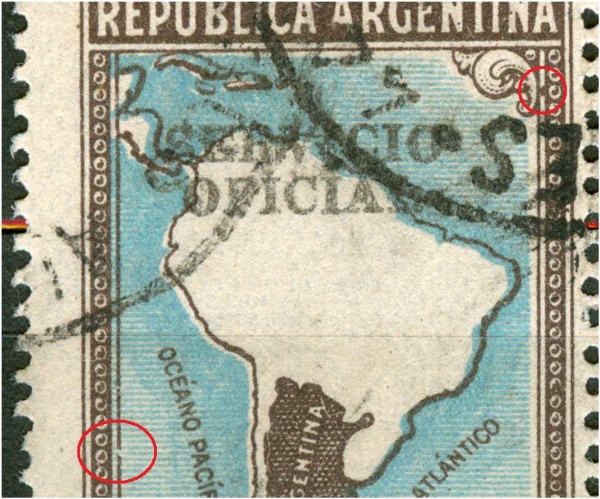
To have 8 out of 80 is not possible statistically when we should deal with a 3rd type of plate characteristics! So I am sure that the two characteristics occur on alternate horizontal rows....
There are some other characteristics that occur also more than once is my modest collection:
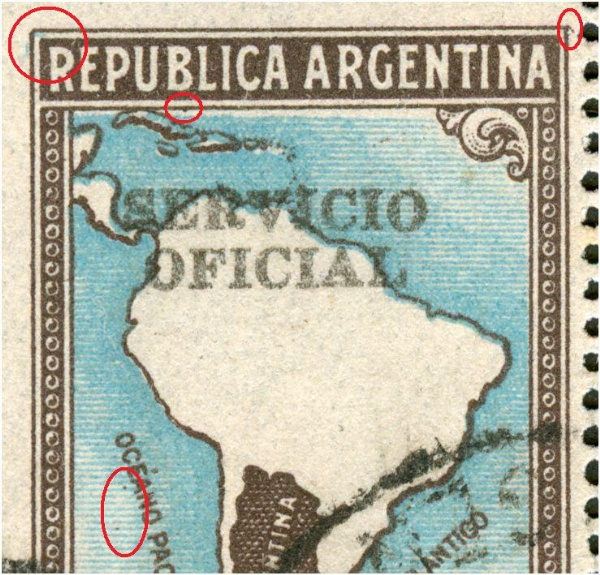
Out of which 8 have the following 2 characteristics:

To have 8 out of 80 is not possible statistically when we should deal with a 3rd type of plate characteristics! So I am sure that the two characteristics occur on alternate horizontal rows....
There are some other characteristics that occur also more than once is my modest collection:

- Rein
- Usuario Colaborador

- Mensajes: 6258
- Registrado: 13 Mar 2009 15:59
- Ubicación: Leiden, Netherlands
- Contactar:
Re: Retoques, errores y variedades de Proceres y Riquezas
I started to look better as these stamps when I had noticed the blue hook in the top left corner 
